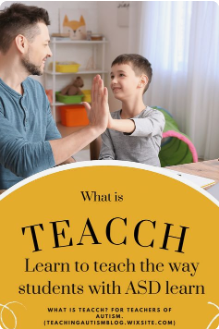What is TEACCH?
- Rosalie Markovics

- Oct 6, 2015
- 3 min read
Updated: Aug 7

For Teachers of Autism. Learn to teach the way autistic students learn.
When I started teaching autistic students, the most obvious aspects of the TEACCH approach we used, were the structured physical environment, which was uncluttered, delineated areas for learning, group work, specific storage areas for different things, and the daily schedule board.
Visual supports were also highly visible to support the students' understanding, both on the daily schedule board, in folders, on mini-schedules, and around the room.
When I read the children's Individual Learning Programs, it highlighted a significant departure from the standard curriculum of a mainstream school.
Each program was individual and was devised by the teacher and the family.
Families could request goals for the teacher to work on, such as personal care goals, or to learn how to ride a bike, or to build on a strength the child had, e.g. reading.
TEACCH TO TEACH
Using the TEACCH approach-
Teachers had to take into account:
-each child's perspective and tailor a program based on the needs and strengths of each child. Teachers need an awareness of how each child learns.

- the need for visuals around the room and as part of their program.
-Help with organisational skills ie. table set up (usually children worked form Left to right with tasks ie. take from the left and then store in finish box on the right), individual work schedules, Finish boxes.
-factor in transitions, both short term (going from play outside to indoors) and long term( a forthcoming excursion), as change can cause anxiety.
-use their strong interests to engage them in their learning and this can also teach them concepts of First,Then on a mini-schedule, and also how to finish activities.
-need for repetition which varied for children. (You also had to teach tolerance for changes).
-need for consistent routines to allay anxiety and then slowly introducing 'Change' and 'Different'.
-need to focus on communication skills in a social setting. Language is taught in an ordered, systematic method, in conjunction with Speech Therapists, and communication activities are embedded in social situations in functional activities e.g. communication during cooking, music, art, play, and excursions.
-sensory likes and dislikes are taken into account. Likes can become part of the child's program as motivators while dislikes are important to know as behaviour always has a why?????
The schedule board reflected the communication level of each student. For example, for students who were non-verbal and on the lower cognitive scale, the schedule board would have actual objects velcroed on the board to show what was happening for that session, while other students were accommodated with pictures, pictures with words, single words, or sentence strips. The teacher could set up the schedule board before the lesson or set it up with the help of the students, to develop their communication skills or reading.
The TEACCH approach makes a good teacher into a better teacher as we hone our observation skills and always build on the child's strengths while breaking more difficult skills down to a starting point appropriate to the child's developmental level.
A TEACCH teacher will always be asking WHY? when something is different. Now, that I also visit mainstream schools, I see a lot more visuals around rooms, focusing on behaviour and expectations and a visual daily program to inform children what is happening during the day.
Check out : Interim Director of Training, TEACCH, Professor Lee Marcus PhD, talks about the TEACCH approach. He can also be found on Youtube.
Website: interactingwithautism.com
For more posts, go back to my Home Page here
Please visit my Autism page here page for lots of interesting posts at (1) Autism | Facebook
.






















Comments